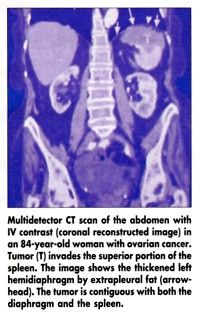Multidetector CT Finds Peritoneal Ovarian Cancer Metastasis
ATLANTA-Ovarian cancer that has metastasized to the abdomen and pelvis can be effectively identified by thin-slice dual-phase imaging and 3D reconstruction with multidetector CT (MDCT) scanning, a technique that appears to be more sensitive and faster than spiral and conventional CT scanners, a new study suggests.
ATLANTAOvarian cancer that has metastasized to the abdomen and pelvis can be effectively identified by thin-slice dual-phase imaging and 3D reconstruction with multidetector CT (MDCT) scanning, a technique that appears to be more sensitive and faster than spiral and conventional CT scanners, a new study suggests.
Elliot K. Fishman, MD, professor of radiology and director of Diagnostic Imaging and Body CT, Johns Hopkins University, and his colleagues presented their study results at a poster session of the 102nd Annual Meeting of the American Roentgen Ray Society (ARRS abstract 259).
Peritoneal metastases are the most common types of metastases from ovarian cancer; they are also the most difficult to detect because of their small size. Dr. Fishman and his colleagues report that MDCT was able to identify metastatic disease at sites, such as the stomach, porta hepatis, and gallbladder fossa, where they may often be overlooked at surgery.
Previous studies have shown that the maximum sensitivity of spiral and conventional CT scanners for detecting peritoneal metastases of ovarian cancer is no more than 80%, and specificity is no more than 85%. Furthermore, sensitivity is only 50% for 5 mm lesions and 28% for lesions less than 3 mm in size.

Possible factors responsible for these low sensitivities, Dr. Fishman said, include the inability to image thin sections through the large volume of tissue from the diaphragm to the pubic symphysis because of pitch restrictions and tube heating.
"Typically, sections of 5 mm to 8 mm are obtained, which may be larger than the size of the metastatic deposit," he said. "Another reason is partial volume averaging of structures oblique or parallel to the axial plane, such as the diaphragm, which can limit visualization."
The Johns Hopkins researchers evaluated the MDCT technique by analyzing 31 thin-slice dual-phase examinations of the abdomen and pelvis conducted in 27 patients diagnosed with ovarian cancer over a 10-month period.
Arterial and venous phase scans of the abdomen and pelvis were performed after a 30- and 60-second delay following injection of contrast. Detector collimation was set at 2.5 mm, slice thickness was 3 mm, and slices were reconstructed every 2 mm with a pitch of 6 (see Figure).
"These smaller slices appear to be a real advantage; we were able to see cancers that had spread that were as small as a few millimeters," said Harpreet Pannu, MD, assistant professor of radiology at Johns Hopkins University. Dr. Pannu also pointed out that the scan time is not increased with the thinner slicesa scan of the whole abdomen and the pelvis takes only about 30 to 35 seconds.
According to Dr. Pannu, MDCT may also be used before surgery to help the surgeon remove the ovarian cancer, and after surgery to see if there is any tumor remaining.